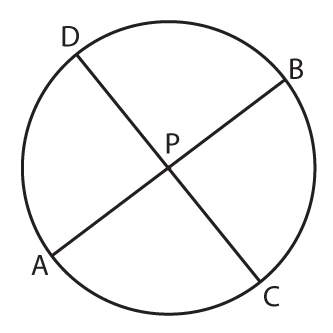Plans
Dashboard
Daily & Speed
Quant
Verbal
DILR
Compete
Free Stuff
Circles
MODULES
Terminologies
Circumference & Area
Chord Properties
Angle Properties
Quadrilaterals in Circles
Tangents
Common Tangents
Past Questions
CONCEPTS & CHEATSHEET
Concept Revision Video
PRACTICE
Circles : Level 1
Circles : Level 2
Circles : Level 3
ALL MODULES
CAT 2025 Lesson : Circles - Chord Properties
5. Chord
A chord is a line segment that has both its end points on the circumference of a circle.| Properties | Figure |
|---|---|
| Centre-Chord Relationships: 1) A line drawn from the centre of a circle to a chord's midpoint is perpendicular to the chord. 2) A perpendicular line drawn from the centre of the circle to a chord, bisects the chord. 3) Perpendicular bisector of a chord passes through the centre. O is the centre of the circle. C is the midpoint of the chord AB. |
 |
| Angle at centre: Equal chords subtend equal angles at the centre. The same hold goods for arcs as well. AB and CD are equal chords. So, they subtend equal angles at the centre, i.e., ∠AOB = ∠COD |
 |
| Angle on Circle: Equal chords subtend equal angles on the circle along their respective major or minor arcs Here, we consider the angles subtended by the equal chords in its minor axis. AB and CD are the equal chords, so ∠AXB = ∠CYD The angles subtended by the equal chords are in their respective major axis (indicated with dotted lines). AB and CD are the equal chords, so ∠APB = ∠CQD |
  |
| Equidistant chords: 1) Equal chords are equidistant from the centre of the circle, i.e., the perpendiculars drawn from the centre of the circle to the equal chords are equal. 2) Chords equidistant from centre are equal, i.e., if the perpendiculars, drawn from the centre of the circle to respective chords, are equal, then the chords are equal. Here, AB and CD are equal chords. OX and OY are perpendiculars drawn from O to the chords AB and CD. So, OX = OY |
 |
| Internal Chords Intersection: When two chords intersect the product of the parts formed by one chord is equal to the product of parts formed by the other. Chords AB and CD intersect at point P inside the circle, so PA × PB = PC × PD |
 |
| External Chords intersection: If the same chords are positioned to intersect outside the circle, then the product of each chord and the chord along with its part outside the circle is equal to the respective product for the other chord. Chords AB and CD intersect at point P outside the circle, so PA × PB = PC × PD |
 |
Example 4
In the figure below, O is the centre of the larger circle where XY is a chord of length 10 cm and XY is also the diameter of the circle drawn through O, X and Y. P is the mid-point of XY and the line joining O and P intersects the larger circle at Q. What is the length of PQ in cm?
(1) 2 (2) 5−2 (3) 5(2−1) (4) 5(2+1)
Answer: 5(2−1)
(1) 2 (2) 5−2 (3) 5(2−1) (4) 5(2+1)
 |
Solution
| As P is the mid-point of XY, which is the diameter of the smaller circle, P is the centre of the smaller circle.
As XY = 10 cm, PX = PY = PO = 5 cm The line joining the mid-point of a chord with the centre of the circle is perpendicular to the chord. ∴ △OPX is an isosceles right-angled triangle, where the angles are 45o−45o−90o, whose sides opposite to these angles will be in the ratio 1:1:2. ∴ As PO =5 cm, OX =52 cm Radius of larger circle = OX = OQ = 52 cm PQ = OQ − OP = 52−5= 5(2−1) |
 |
Answer: 5(2−1)
Example 5
A circle with 17 cm radius is drawn with O as the centre. In this circle, chords AB and CD intersect at E such that EC =6 cm and CD =26 cm. If AB passes through O, then what is the length of BE (in cm) if O lies between A and E?
Answer: 4
Solution
| ED = CD − EC = 26−6=20 cm As the radius is 17 cm, the diameter AB has a length of 34 cm. Let BE = x. Then, AE = 34−x x(34−x)=6×20 ⇒ x2−34x+120=0 ⇒ (x−4)(x−30)=0 x=4 (x=30 is rejected as BE < AE) |
 |
Answer: 4
Want to read the full content
Unlock this content & enjoy all the features of the platform
Subscribe Now